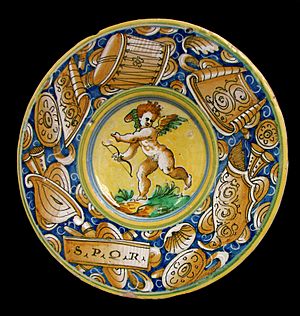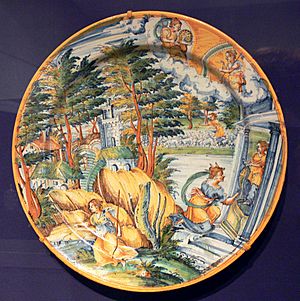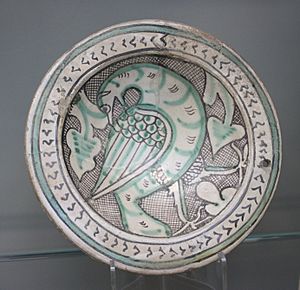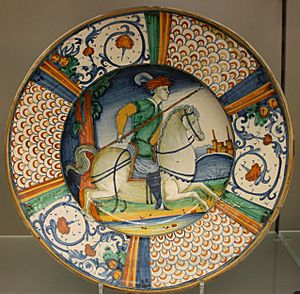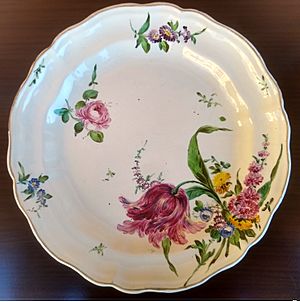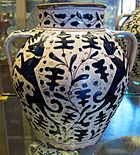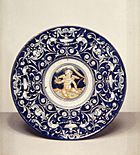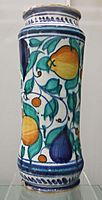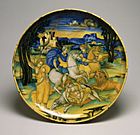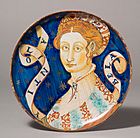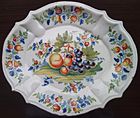Maiolica facts for kids
Maiolica (say: my-OL-ih-kuh) is a special type of tin-glazed pottery. It has colorful designs painted on a bright white background. The most famous Maiolica pieces come from Italy during the Renaissance period.
These beautiful artworks were often called istoriato wares. This means "painted with stories." They showed scenes from history or myths. By the late 1400s, many places in central and northern Italy were making these fancy pieces. They were sold as luxury items in Italy and other countries.
Maiolica also developed in other places. In France, it became known as faience. In the Netherlands and England, it was called delftware. In Spain, it was known as talavera.
What's in a Name?
The name Maiolica likely comes from Majorca. This island was a stop for ships bringing pottery from Valencia to Italy. Some people think potters from Majorca worked in Sicily. Their pottery might have reached Italy from Caltagirone.
Another idea is that the name comes from a Spanish phrase. Obra de Málaga meant "wares from Málaga." Or it could be obra de mélequa, the Spanish name for a shiny finish called lustre.
In the 1400s, maiolica only meant pottery with a shiny, metallic look. This included both Italian and Spanish pieces. Plain white tin-glazed pottery was called bianchi (whiteware). By 1875, the name maiolica was used for all tin-glazed pottery made in Italy, whether it had a shiny finish or not.
When the Spanish took over the Aztec Empire, they started making tin-glazed Maiolica in Mexico. This began as early as 1540. They copied pottery brought from Seville. Mexican Maiolica is now famously known as 'Talavera'.
Today, the name "maiolica" can describe any tin-glazed pottery made in the Italian style. Other names like faïence or delftware are used for later pottery from the 1600s onwards. These later styles were either new French designs or Dutch-Chinese styles (like Delft pottery). Sometimes, modern artists making tin-glazed pottery also use the term "maiolica."
How Tin Glazing Works
Tin glazing creates a white, opaque surface. This surface is perfect for painting colorful designs. The colors are made from metallic oxides or special glass powders. These are painted onto the unfired glaze. The glaze soaks up the color like a fresco painting. This means you can't fix mistakes, but it keeps the colors bright.
Sometimes, a second clear glaze is put over the first one. The Italians called this coperta. It makes the pottery even shinier. For pottery with a special metallic shine (lustre), it needs another firing. This firing uses less oxygen and is done at a lower temperature.
Pottery kilns needed wood for fuel and good clay. The glaze itself was made from sand, wine lees (leftover from wine making), lead, and tin. Tin-glazed pottery can sometimes chip easily and is quite delicate.
Studies of old Italian Maiolica show that tin was not always in the glaze. The chemical mix of the glaze changed over time.
The Maiolica art form began in the 1400s. It grew from older medieval pottery that used lead glaze. Potters improved these by adding tin oxides. This idea came from Islamic pottery brought through Sicily. These older pieces are sometimes called "proto-maiolica."
In the late 1300s, the colors used for lead-glazed pottery expanded. They added cobalt blue, antimony yellow, and iron-oxide orange. Before, they mostly used manganese purple and copper green.
Another style was Sgraffito ware. Here, the white tin-oxide glaze was scratched away. This revealed the clay body underneath, creating a design. Old sgraffito pieces found in places like Bacchereto, Montelupo, and Florence show this style was made widely. It was not just in Perugia and Città di Castello as once thought.
Where Maiolica Was Made
Making tin-glazed pottery for more than just local use began in central Italy. This started in the late 1200s, especially around Florence. The Della Robbia family, famous sculptors from Florence, also used this type of pottery.
Florence itself became less important for Maiolica making after the mid-1400s. This might have been because of too much tree cutting in the area. Production then spread to smaller towns. After the mid-1400s, Faenza became a key center.
Potters from Montelupo started the pottery workshops at Cafaggiolo. In 1490, 23 master potters from Montelupo agreed to sell their year's pottery to Francesco Antinori of Florence. In 1495, the Medici family set up these experienced Montelupo potters at their Villa Medicea di Cafaggiolo.
In the 1400s, Florentine pottery encouraged Maiolica production in Arezzo and Siena.
Italian Maiolica became incredibly good during this time. In Romagna, Faenza made fine Maiolica from the early 1400s. This city was unique because pottery became a huge part of its economy. Bologna made lead-glazed pottery for export. Orvieto and Deruta also produced Maiolica in the 1400s.
In the 1500s, Maiolica production started in Castel Durante, Urbino, Gubbio, and Pesaro. The early 1500s saw the rise of istoriato wares. These pieces had detailed paintings of historical and mythical scenes. The State Museum of Medieval and Modern Art in Arezzo has Italy's largest collection of istoriato wares. The British Museum in London also has many examples.
Some Maiolica was made as far north as Padua, Venice, and Turin. It was also made as far south as Palermo and Caltagirone in Sicily, and Laterza in Apulia. In the 1600s, Savona became an important pottery center.
The many styles that appeared in the 1500s are hard to count. One expert found four styles with 20 sub-groups for Pesaro Maiolica. Another categorized Ligurian pottery into four types, eight sub-categories, and 36 smaller divisions. This shows how diverse the styles were. You can see this variety by comparing apothecary jars made between the 1400s and 1700s. Italian cities helped the pottery industry by offering tax breaks, citizenship, and protection from imports.
A key book about Maiolica painting techniques from the mid-1500s is by Cipriano Piccolpasso. Famous masters from the 1500s include Nicola da Urbino, Francesco Xanto Avelli, Guido Durantino, and Orazio Fontana from Urbino. Also, Mastro Giorgio from Gubbio and Maestro Domenigo from Venice were well-known. Gubbio's special lustre used greenish yellow, strawberry pink, and ruby red colors.
In the 1700s, fine Maiolica faced more competition. New materials like porcelain and white earthenware became popular. But the 1700s were not just a time of decline. To compete with porcelain's bright colors, a new technique was introduced. This was called "third firing" (piccolo fuoco). It started in North-West Europe around the mid-1700s.
After the pottery was fired twice at high temperatures (about 950 °C), it was painted again. This time, colors that would fade at high heat were used. Then, the pottery was fired a third time at a lower temperature (about 600-650 °C). This brought in new, bright colors, especially red and pink shades made from gold chloride.
It is believed that Ferretti in Lodi, northern Italy, was one of the first to use this technique in Italy. Lodi Maiolica was already very good in the early 1700s. With the third firing and a growing interest in plants, a refined style of Maiolica with realistic flower designs developed.
Today, Italian Maiolica is still made in many places. You can find it as folk art and as copies of old styles. Some main centers like Deruta and Montelupo still make Maiolica. They sell it all over the world. Modern Maiolica looks a bit different from old Maiolica. Its glaze usually uses cheaper zircon instead of tin to make it white. However, some potters specialize in making real-looking Renaissance-style pieces with true tin glaze.
Gallery
-
Faenza, Casa Pirota workshop, circa 1510–1530 (Walters Art Museum)
-
An albarello (drug jar) from Venice or Castel Durante, 16th century. Approx 30 cm high. Decorated in cobalt blue, copper green, antimony yellow, and yellow ochre. Burrell Collection
-
Faenza, istoriato ware by Baldassare Manara, after Giovanni Antonio da Brescia, circa 1520–1547 (Walters Art Museum)
-
Maiolica dish, circa 1537 at Waddesdon Manor
See also
 In Spanish: Mayólica para niños
In Spanish: Mayólica para niños
- Majolica
- Francesco Xanto Avelli
- Manises
- Nicola da Urbino
- Nove Ware
- Royal Factory of La Moncloa (Spain)
- Talavera de la Reina pottery (Spain)
- Talavera, Mexican maiolica
- Tin-glazed pottery
- Victorian majolica
- Lodi ceramics


